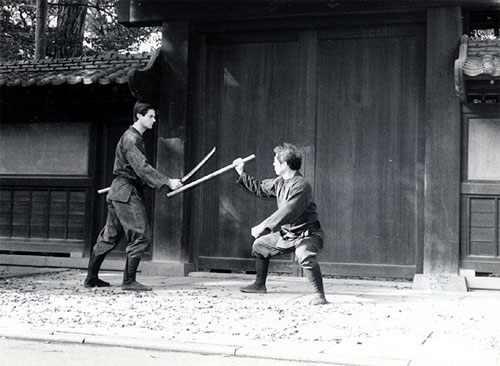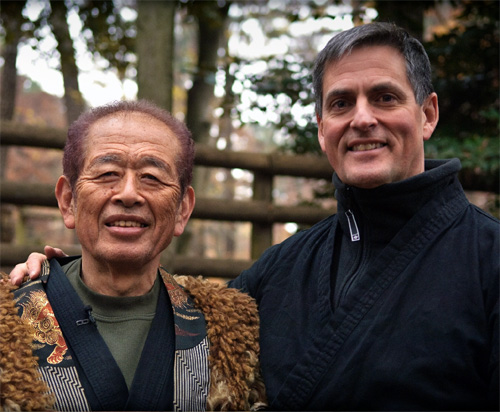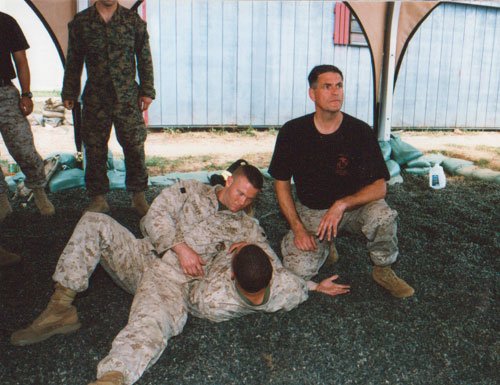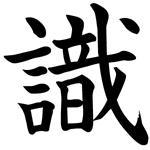
New Year's Message
January 1, 2009
Dear Buyū:
Happy New Year! I hope you and your family have a wonderful 2009.
Looking back over 2008, I am grateful once again to have been able to train with so many Buyū from around the world. Domo Arigato!
For our Buyū training group, this summer marked the eleventh anniversary of Buyū Camp West in San Francisco under the Golden Gate Bridge on the Pacific Ocean, as well as, a fifth Buyū Camp East in New Jersey. Click the respective links to see some photos. Buyū Camps are a great way to connect with old friends and get that "continuing education" and inspiration that will help you "keep going" when you get back to your own, local training group. See you in San Fran and/or NJ again in 2009!
I was in Japan for the Daikomyosai - Hatsumi Sensei's annual 3-day training event. It was an extra special training experience outside in Shimizu Koen (Park). It was wonderful to train outside among the beautiful turning leaves of the Japanese maples. We worked on the basics of our art; and it was a marvel to watch Hatsumi Sensei - at age 77, mind you! - rolling around on the ground, poking people with sticks, and bouncing heads off of trees. Our art is definitely made for the outdoors.
When I was a younger man, recently released from active duty in the Marines, I spent a fair amount of time in Shimizu Koen. In those days there usually weren't any other foreigners in Noda. It was a little lonely sometimes; but I had a routine. My day started out every morning (and I mean EVERY morning) with a breakfast of saba (an oily breakfast fish), rice and miso soup with the three ladies in my life: Oba-san (grandmother), Oka-san (mother), and daughter Mitsuke at the ryokan where I lived. After that I would read, write, and review my notes for a couple of hours. Then it was off to lunch at the one place I knew where I could get karaage (fried chicken) and a salad - something that remotely reminded me of food from home.
In the afternoon I would go visit Hatsumi Sensei, helping him with this or that, or just taking advantage of an excuse to be around him.
On the days that Sensei was busy or had patients, I would go down to the Edo river and follow it to Shimizu Koen, just walking around and practicing my movement skills. I had a sempai named Muramatsu who was drilling me in the kihon basics of our art, as well as, ninja walking, leaping and stealth movement. They say that the most important part of martial arts training is the training you do by yourself. I did a lot of it at Shimizu Koen.
In the evening there was usually training some place - Noguchi Sensei's or Ishizuka Sensei's dojo in Kashiwa (nicknamed "Samui Dojo" because it was unheated in the winter; it also had an outhouse that was an experience any time of the year). Sometimes we went to the local jinja shrine to train or take pictures.

Training photo, Noda City, circa 1986
The scariest place to train for me was the dojo of a man some of us met for the first time at the Daikomyosai in Shimizu Koen. The Vice President of the park is Mr. Kobayashi, who was introduced near the end of the training. Although it does not appear that he actively trains anymore, he was one of Hatsumi Sensei's first students many years ago, and one of the few who actually met Takamatsu Sensei. He spoke movingly about meeting his teacher's teacher and how awed he was by him. Kobayashi san came across as a very nice, modest gentleman. Let me tell you, though, 25 years ago he came across a little differently, as an accomplished and serious martial artist. And tough! It was great to see him, but he still makes me a little nervous!
I have been at virtually every Daikomyosai since Yuma Mura in 1983, and I don't know how many more times we will all get to meet at a Daikomyosai in the future, but 2008 in Shimizu Koen will stand out as an especially wonderful experience.

Daikomyosai 2008 photo by Sheila Haddad
Some of the most motivating training I did, again in 2008, was with the Marine Corps Martial Arts Program (MCMAP) in Quantico, Virginia. This fine program, led ably by my friend Joe Shusko (LtCol USMC ret.) covers the armed and unarmed martial arts techniques and combat conditioning that a Marine needs to walk the warrior path - both in combat and in daily life.
Joe's efforts to develop Ethical Marine Warriors through MCMAP makes him one of the unsung heroes of our nation. Developing Ethical Warriors is a synergistic process that clarifies, activates and sustains Warrior Ethics. Clarify means: What is the Warrior Ethic? Activate means: How do I get the feeling of it, deep in my conscience, deep in my guts? Sustain means: Once I get the feeling, how do I keep it from wearing off, especially under the stress of combat, but also through the challenges of everyday life?

The foundation of the Warrior Ethic is our 1776 value - "all men are created equal", which is an acknowledgement that there is a Life Value that is a universal value shared by all people. Actually, as Bob Humphrey pointed out, it is a dual value – self & others. The Dual Life Value - and its corollary, human equality - is the basic premise of the Warrior Ethic.
The great moral values, such as truth, freedom, charity, honor, courage, commitment, etc. have one thing in common - when they are functioning correctly, they are all life-protecting. But they are still relative values. Our relative moral values must be constantly examined to ensure that they are always performing their life-protecting mission. For example, courage can become foolish martyrdom; commitment can become irrational fanaticism; honor can become self-righteousness, conceit, and disrespect for others. As relative moral values they must always remain grounded in the Life Value.
Ethics are moral values in action. It starts in the school yard. Most everybody knows that the bully is wrong - that's morality. But only a few will speak up to protect the one getting bullied by calling for a teacher - that's ethical behavior. Even fewer will step in physically to actually protect the child being bullied - that’s the behavior of an Ethical Warrior. Ethics are moral-physical. Moral people may want to step up and do the right thing, but they often lack the physical courage and ability. Martial arts gives them the necessary skills and confidence. And that is why Ethical Warrior training includes - and must include - martial arts.
Warriors protect life, even at risk of their own. And they kill only if necessary to protect life. Respect for the Dual Life Value sets them apart from those who may appear "moral" within the context of their own environment or culture, but who do not respect the lives of others outside their own "in" group.
But sustaining this clarity of values is a challenge. To accomplish anything good in this world almost always takes great perseverance. For you other "Don Quixotes" out there, here is something that I was able to articulate for myself this year, and I'd like to share it with you. Ready? Here goes:
"Saving the world is like mowing your lawn; you have to do it about once a week."
Sustainment is just a fancy word for consistency in your moral-physical training regimen. That is what "keep going" really means, I think. It means "keep training." Keep training, even when there just seems no way to make the time, even when you have a really good excuse to stop or "take a break." Never stop, even when your life becomes complicated or difficult (and it always does, for all of us). KEEP TRAINING ANYWAY!
Why is this so very important? The obvious answer is, that you just never know when you might need your physical skills. It could be never; it could be in 5 minutes. As a warrior, we are pledged to protect the life of self and others. We have the responsibility to stay sharp and physically ready.
But it is more than that. We are talking about the possibility of violence between human beings. The danger is more than physical; it is also psychological or spiritual. Forget the fantasies. There is sufficient evidence that real violence and killing is so abhorrent to normal humans that it is inherently damaging to virtually everyone who participates. Even if you "win," or even if it is "justified," exposure to violence and/or killing is a life-altering event for most of us. In fact, it could be said that it would be unnatural if people DIDN'T get some degree of PTSD (post-traumatic stress disorder) from exposure to violence. That is why, I believe, that the escaping or hiding nature of Ninpo is so important - it teaches that avoidance protects our bodies AND our spirits.
But, it is not always possible to avoid violence. Therefore, a physical-moral training regimen can inoculate the warrior from the stress of combat and mediate the effects of PTSD afterward. Hatsumi Sensei's unique training methodology has shown us the way. Professor Humphrey's Warrior Creed speaks to the ethic.
Wherever I walk,
everyone is a little bit safer because I am there.Wherever I am,
anyone in need has a friend.Whenever I return home,
everyone is happy I am there."It's a better life!"
Warriors do two things: they fight in wars; and when they are not fighting, they train. That's it. Everything else wraps around it. Hatsumi Sensei is still training at 77. Professor Humphrey fought on Iwo Jima, then trained consistently until the end of his life. He knew what he was talking about.
If you are interested in experiencing more of Robert L. Humphrey's Life Values teachings, we'll see you at the "Ethical Warrior" seminar next July in New Jersey.
And please consult the WIN seminar page periodically for details of all of our workshops.
Which brings us to 2009. In a recent letter Hatsumi Sensei wrote:
Next year is the time for "Shiki," the "Shiki" of Chi, Sui, Ka, Fu, Ku, Shiki. The Bujinkan will mature with that state of mind. Which means that it is the year of acknowledgement....
People tend to struggle to reach some goal and think that life is fulfilled only when that goal is fulfilled. People don't appreciate their day to day life because they are too busy chasing whatever they think they should be. That is against "shiki" because it is an obsession of thought.
Interesting... "shiki" is usually used with other words nowadays to add the meaning of "knowing," "understanding," "acknowledging," and so forth.
But I believe Sensei is referring to the "shiki" which is more like an all-encompassing sense: Sense of seeing, hearing, smelling, tasting, touching, etc. It is like the counterpoint to the concept of the void, or kuu - like an awareness of everything in every way. What we "think" is incomplete, therefore, and may be no more than an illusion. We must integrate all of our senses - and more. When we can do this, it is said, then we can glimpse the beginning of enlightenment.

shiki
As always, I hesitate to say I "know" what Sensei is really saying until the lessons reveal themselves over the course of the training year. The best way to keep up with what Hatsumi is saying about training in 2009 is to go to Japan, of course. But, between trips, I highly recommend Doug Wilson's blog. It appears that Hatsumi Sensei has already started to elaborate on some important concepts as they pertain to our training; check out Doug's blog here to read more. There is also a lot of good information on Joji Ohashi's site here.
Each year I also like to introduce a complimentary "Buyū theme" of our own. This year, the theme is "integration." We will start off the year with exercises that will help us better integrate the movements of our bodies, and then move on to integration of our warrior training with the world outside the training hall. As I said above, warriors fight in wars, and when they are not fighting, they train. Most of us are too lucky or old (I am both!) to fight in a war. That means that there is nothing left but the training. Keep training and approach all of your life from the perspective of the Ethical Warrior. Sure, we have jobs and families, etc., but bless your luck if you have not been called to fight - right now those folks are far from home, and have left their jobs and families behind. Pray for them and keep training in 2009.
Thank you, Buyū, for helping me to keep training this year!
Jack Hoban
